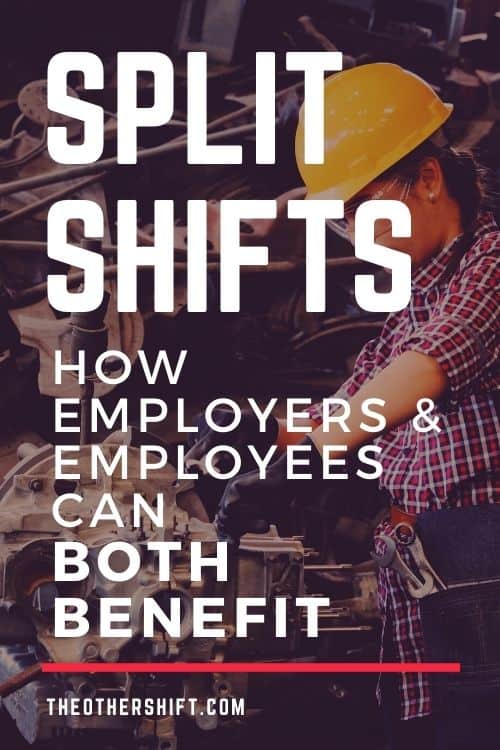Disclosure: This page may contain affiliate links, meaning we receive a commission if you decide to make a purchase through our links, but this is at no additional cost to you. Please read our disclosure and privacy statement for more info.
Scheduling has been the downfall of many companies over the years. From mom and pop gas stations to high-class businesses – how can you schedule staff to maximize profits and their overall wellbeing? More than ever, all parties require flexibility and split shifts could be the answer to everyone’s needs.
Split shifts; working multiple shifts on a given day, with a break in-between of minimum 2 hours, may reduce staff burnout, increase profits and productivity, and provide better work coverage. Running errands and completing tasks throughout the weekday is often easier with this schedule.

In today’s society, you will notice that plenty of companies require flexibility and have steered clear of traditional scheduling. Instead, we have seen a spike in the implementation of shift work and alternative scheduling, such as split shifts.
So before implementing a split shift we need to ask, how do we survive split shifts? The steps to surviving split shifts are simple: understand what a split shift is, understand what industries benefit from split shifts, understand scheduling, understand benefits for both the employer and employee and how to make the most of it.
What Is a Split Shift?
Working in today’s society, you will see a growing number of companies who elect to roster staff outside of traditional scheduling. Doing this is known as shift work. Shift work comes in all different shapes and sizes, one of them being split shifts.
So, what exactly is a split shift?
The concept of split shifts is one that is fairly simple to understand, although there are some complicated parts.
For a shift to be considered “split,” there needs to be a gap of two hours or more in between the times you are scheduled to work within a single day.
For example, you could work from 8am-12pm and then clock out. From there you get to do whatever you wish for two or more hours. Then, you would come back that same day and work something like a 3pm-8pm to finish out the night.
Do not get this gap confused with lunches or rest periods – these are not at all the same. In fact, most employers will insist you leave the premises during your time off – that way they are not being held liable or breaking any rules.
Split shifts are regular working days, just with a little bit of finesse to them. Some may think of the gap between working hours as a midday break.

Typical Industries
Operating using a split shift type of scheduling just isn’t a perfect match for all industries. If you are a business that is booming from start to close – you may not be able to implement this type of schedule.
On the other hand, if you are in a workplace where you have work that increases during a particular time – you could surely benefit from it.
For example, if you are busier throughout the morning – you could schedule more employees during that period. The goes for the “slow” hours – let people go home so they are not standing around and having them take a salary for not much work.
The main industries that will see a split shift established are businesses within the hospitality field or work-from-home industries. A few examples will be listed below.
- Restaurants
- Bars
- Hotels
- Events
- Data entry
- Remote Call Centers
- Bus drivers
- Health & Fitness (Personal Trainers & Gyms)
Keep in mind that these are just examples of industries that have been seen using split shifts. This is not a definite list, and not every business in these industries use split shifts.
There are plenty of other scheduling types that are floating around out there. Also, if you are not one of the businesses listed – you can still find ways of benefiting from split shifts. Find what works best for your company individually.
Related post: What Do the Terms 1st, 2nd and 3rd Shift Actually Mean?
One of the other types of scheduling is rotating shift work. Check out the video below which can also be found on our YouTube Channel, which answers some of the common questions Em gets asked as a rotational shift worker.
Split Shift Schedules
When it comes to scheduling, there are no typical “time slots” to choose from. This is where the hard work comes into play. You have to find a split shift that is particular to your company’s needs.
Determine what time slots you need more coverage, and what time slots you can handle with less coverage – begin creating your split shift schedule from that information. An example of what a schedule could look like is listed below;
Example 1 – Busy periods are the morning and evening (think a Personal Trainer)
Split Shift Part A – 5am – 10am
Split Shift Part A – 3pm – 8pm
Example 2 – Busy periods are at lunch and dinner (think Hospitality – Chef or Waitress)
Split Shift Part A – 10am – 2pm
Split Shift Part A – 4pm – 10pm
Keep in mind that these are just a couple of examples out of multiple that you can choose from. It really is all about making sure that whatever schedule you pick is the most optimal for your company’s individual needs.
Scheduling can be overwhelming – if you swap over to split shifts you may want to consider investing in a scheduling tool to assist.
Using an app to get your shifts organized is a good idea! Here’s a post that will be pretty helpful about now.
Alternatively, consider investing in a smart watch. While Apple Watches are quite the investment, it could be the answer to staying organised. Here is a link to Amazon if you feel like doing some shopping.

Benefits of Split Shifts to the Business
Business owners, this one’s for you.
Should you want to transition your business to something new – scheduling included – it is important to know how you can benefit. This isn’t selfish or self-centered – it’s strategic.
Benefits of a split shift can include reduced staff burnout, increased productivity, better coverage, and having the upper hand on cost control.
Reduce Burnout
Burnout plays a huge factor in the success and failure of your business. Keeping employee burnout at a low number is something you should always be striving for.
Implementing a split shift can lead to reduced employee burnout.
Split work guarantees a certain amount of time off throughout the day. Whether that be two hours or longer. Regardless, your employees are getting time away from working. This gives employees time to mentally recoup and recharge, a great way to reduce burnout.
Related post: Shift Work Burnout: Causes, Red Flags and How to Beat It
Increased Productivity
When you have a traditional schedule implemented, you might find that your employees have times in which their productivity levels decrease. This could be due to the fact that they are in the office for long periods of time.
Split shifts could equate to an increase in productivity because employees are getting more time outside of the office.
For the factory workers amoung us, do you feel like your stuck doing the same old thing? This post will help Factory Work is Depressing. Control How It Impacts You
Better Coverage
Coverage is something that is already difficult to come by – every business owner knows that struggle.
With a split shift, you are able to alleviate some of that stress. As an owner or manager, there is nobody that knows the inner workings of your business better than you do. Therefore, you know what hours need more resources.
Whether that be during the morning rush or during the lunch hours – you know where your company can benefit from more hands-on deck. Implementing a split shift allows you to take the reigns over your scheduling conflicts.
Cost Control Maintenance
A big incentive for swapping over to split shifts could mean lowering the cost of labor.
Understanding the hours you need more coverage, and what hours you need less coverage is essential. Doing this means that the amount of work you have available is covered with the perfect quota of employees, saving you those precious pennies in the process.
Related Post: 13 Advantages of Shift Work for Employees

Benefits to Employees?
In order to work properly, there has to be benefits that are reaped from all parties involved. Certain employees really enjoy the freedom that can come with split shifts and what you can achieve in your time off.
Run Errands
Errands seem like they control our lives, but there is never enough time in a day to get them done.
Operating on a split shift provides you the freedom to get those ever-nagging jobs done. Each shift you know that you’ll have at least two hours off between your working hours, which gives you time to go grocery shopping, pay bills, take your dog to the dog park – whatever it is you need to do.
Personally, the extra time alleviates tons of unneeded stress.
Flexible Hours
Flexible hours will always be a perk of shift work scheduling, and split shift work is no exception.
Working traditional shift work hours could mean having to give up time with your friends and family. You may have to give up events you don’t want to miss. With the flexible hours of split shift – you have extra time during some point of your day to schedule extracurriculars.
Related post: No More Relationship Problems Because of Opposite Schedules
Convenience
Like all shift work – split shifts have proven to be very convenient for a lot of employees. This isn’t a normal Monday through Friday, 9 to 5 type of job. There are working hours available all throughout the morning, evening and night.
If you are a morning person, then I’m sure you can find yourself a job that allows you to work when you are most productive, whilst the same going for night owls who take some time to warm up.
Leave Work at Work
This is my favorite thing about split shifts. The work that you don’t finish at work isn’t typically work that has to follow you home.
Generally speaking, you have someone coming in to relieve your duties – taking over the work you did not get to finish at that point during day. This is so refreshing because it means you get to come in the next part of your shift and focus on what’s required at that point in time. This benefit cannot be said for all, but it can be said for most.
Because split shifts are designed to generally favor managers/owners, employee benefits are not as prominent as employer benefits. However, there is still plenty to like for those who live a flexible lifestyle.
Related Post: Shift Work vs 9-5: What Working Schedule Best Suits You?

Potential Cons to Split Shifts
No schedule is going to be perfect for the employer or employee. There will always be variables that don’t suit either party. So, if you are looking into implementing a split shift at your place of business, you need to understand the potential issues. Below are some areas to consider;
Inconvenient Commute
Here is one of the major downfalls of a split shift – commuting.
Split shifts mean that you are driving from work to home (or another undisclosed location) more times than you would on a traditional schedule.
You have to go to work, go home, go back to work, and go back home. Seems like a lot, right? It is, but you can try things like carpooling to reduce your carbon footprint and cost incurred!
Need help getting home when you’re feeling tired? Here’s a post that will help you out.
As a little ninja tip for getting home, pack an eye mask in the car. Block out the light so you can quickly fall asleep. This is the one we love at the moment.


Communication Issues
There is a huge chance of an increase in miscommunication.
This happens because employees are working weird hours – with not everyone always in the building at the same time. This means there is a higher chance of things falling through the cracks if you are not careful.
There are tools made available to ensure that all items are being clearly communicated. No stone should go unturned. If not implemented correctly, the lack of communication could be detrimental to your success and overall productivity.
Fluctuating Schedules
If you are not careful you may find yourself having issues with your employees’ work hours fluctuating throughout the week.
Your peak periods can be different from day to day – for example, you may not be busy at the same time Wednesday that you are on a Sunday. Therefore, your employees could end up being yanked around different hours throughout the week, which could cause emotional and physical stress.
It’s important to try and provide consistency where possible and give any employee as much notice as possible to what their future shifts will look like.
Feelings Of “Never Leaving”
Now a positive of this roster can reduce staff burnout and increase productivity, however, if not handled in the right manner, staff can sometimes feel as if they are still “working”, even when on the break component of the split shift.
Employers need to make sure they don’t take advantage when the employee has finished their hours, whilst staff need to make sure they mentally and physically distance themselves from the workplace to ensure their mind and bodies are recharging. If the employee can go home, this is always recommended. Otherwise, find yourself a happy place and spend time there doing what you enjoy.
Related post: Shift Work and Family. A Practical Guide For Busy Parents
[VIDEO] – If you’re split shift takes you from nights to days, this video will help with the transition.
If you are an employer reading this article and we’ve convinced you that a split shift could be an option, we suggest you take it on a test run before completely adjusting what your staff have previously been accustomed too.
Instill the shift with a combination of those staff who are more dynamic, along with those who like consistency, so you receive a wide array of feedback. Once you have a true sample of how it has impacted your business along with staff morale and productivity, you are now in a position to make a change.
Any employee reading this who might want to try this line of work, go to any job site on the internet and search for “split-shift”. I’d be very surprised if you can’t find a position that meets your needs.
Alternatively, if you feel like this type of roster would increase profits for your current business owner, along with an improved headspace from you, then don’t be afraid to suggest this as an option. Be sure to offer up your services to assist with the transition!
Split shifts are becoming more common throughout the world, especially with more people working random hours. We hope you were able to take away something new from this article or potentially make you see this type of shift work in a new light. You never know what benefits can come from having periods of time free throughout the day…. So much time for activities!
Cheers,

Disclosure: This page may contain affiliate links, meaning we receive a commission if you decide to make a purchase through our links, but this is at no additional cost to you. Please read our disclosure and privacy statement for more info.
Recent Posts
An examination of the night shift professions, that while sometimes underappreciated, are necessary for civilization, in its current form, to exist. A city can be thought of as a machine. Each...
Culminated from an exhaustive yet well-funded journey into the night, this article will prepare you for life outside of work while being a denizen of the dark. During days off, night shift...

